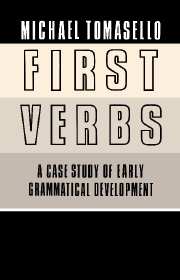Book contents
- Frontmatter
- Contents
- Acknowledgments
- Dedication
- 1 Introduction
- 2 In the beginning was the verb
- 3 Methods and an introduction to T's language
- 4 Change of state verbs and sentences
- 5 Activity verbs and sentences
- 6 Other grammatical structures
- 7 The development of T's verb lexicon
- 8 The development of T's grammar
- 9 Language acquisition as cultural learning
- References
- Appendix
- Index
6 - Other grammatical structures
Published online by Cambridge University Press: 18 December 2009
- Frontmatter
- Contents
- Acknowledgments
- Dedication
- 1 Introduction
- 2 In the beginning was the verb
- 3 Methods and an introduction to T's language
- 4 Change of state verbs and sentences
- 5 Activity verbs and sentences
- 6 Other grammatical structures
- 7 The development of T's verb lexicon
- 8 The development of T's grammar
- 9 Language acquisition as cultural learning
- References
- Appendix
- Index
Summary
Although it is the premise of this monograph that much of children's earliest language is structured by verbs and other relational words, they do have other ways of structuring multiword constructions. For T these were quite limited in the first few months, but by the end of the current study they were many and diverse. In this chapter, I report on three classes of grammatical phenomena that were not touched on in the previous analyses of verb-based sentences. First, I report on T's early sentences without verbs or relational words of any kind. This includes object–object constructions, and some possessives, locatives, and attributives – along with an account of the copula, which many of these verbless sentences would require in adult English. Second, I will report on T's grammatical morphology. This includes accounts of noun morphology (possessive, plural), the development of various noun-phrase phenomona (pronouns, articles, adjectives), verb morphology (past and future tenses, progressive aspect), the development of various verb-phrase phenomena (verb particles, prepositions, auxiliaries, adverbs), and subject–verb agreement. Finally, I will recount T's complex sentences including negatives, questions, and sentences with more than one verb; of course, many of these include grammatical morphology as well. Each of the subsections within these three sections has associated with it either an appendix, a table, or both, which list the data on which the discussions and analyses are based. There is a brief summary at the end of the chapter.
One caveat. In describing T's language in the following analyses I use a number of adult linguistic terms (e.g., articles, prepositions, the copula, noun phrase).
- Type
- Chapter
- Information
- First VerbsA Case Study of Early Grammatical Development, pp. 147 - 186Publisher: Cambridge University PressPrint publication year: 1992



